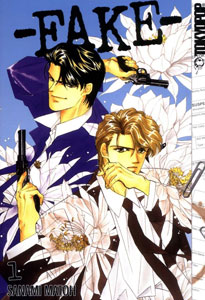Yaoi

The word Yaoi (debated pronouncions "Yah-Oh-ee," "Yah-oh-ih" & "Yah-oy") was originally used to refer to fan manga (such as doujinshi) that focused on homosexual relationships between male characters, especially two bishōnen - the manga equivalent of slash.
The term is an acronym derived from the Japanese phrase 「ヤマなし、オチなし、意味なし」 ( yama nashi, ochi nashi, imi nashi ), meaning "no climax, no punch line, no meaning." Its target audience, readership and creators are mostly young to middle-age women, with men of the same age comprising most of the rest. The generally accepted theory as ot the cause of this is that heterosexual women find male/male relationships erotic, much as some men consider lesbian relationships appealing, and that while gay men do have just as large an interest, there are simply fewer of them in the world than there are women.
The attraction is often focused on the romantic situations more than the actual homosexuality and homoeroticism.
The term is often used in a general way to refer to male-male sexual or romantic content anywhere in anime, manga and fan fiction based on these; usually of a more sexually explicit nature than the now-obsolete shōnen-ai.
The term "BL" (Boys' Love) is more often used in Japan than the term Yaoi, and all commercially published works are referred to as Boy's Love. There exists a large mainstream market for Boys' Love comics in Japan, as well as a flourishing dōjinshi market. In recent years, several popular Japanese BL works have been commercially translated and imported to English-speaking countries by companies such as Be Beautiful and Digital Manga Publishing. Currently-available works include Kazuma Kodaka's Kizuna and Only the Ring Finger Knows by Satoru Kannagi and Hotaru Odagiri. Whether such works will have comparable popularity in English-speaking countries remains to be seen.
Over the years, gay-themed comic strips inspired by and referred to as yaoi have been adapted as a sub-culture in North America, with writings and art displayed on websites devoted to it. Notable American yaoi comics include the webcomic Boy Meets Boy by K. Sandra Fuhr, and its successor Friendly Hostility hosted on Keenspot.
Some common subjects of the American yaoi subculture include the boys of Trigun, Cardcaptor Sakura, Dragon Ball, Final Fantasy, Gravitation, Gundam Wing, Naruto, Prince of Tennis, Weiss Kreuz, Yu-Gi-Oh!, and YuYu Hakusho. Generally speaking, if a series features attractive male characters, it will attract yaoi fans. Thus a large amount actually comes from male-oriented shounen & seinen demographics. This sometimes causes conflict because many fans dislike such themes, especially when inserted as fanon.
Yaoi is often thought of as more "story-based" than heterosexual hentai manga or anime; however, a broad spectrum of "intensity" exists in the genre. Themes range from ordinary themes and mild adult situations to extreme fetish-oriented works, including anthromorphism, cosplay, nonconsensual sex ("non-con"), and even monsters, incest, orgies, and assorted other highly taboo depictions of homosexuality. However, in Japan, yaoi is pure smut whereas BL actually has a plot & story.
Interestingly, though protagonists are male, definite gender-related power structures are prevalent in much of the genre. The "seme," (攻め) or "giving," tends to be depicted as the standard male of anime and manga culture: restrained, physically powerful, protective. The "uke" (受け), or "receiving," may be more androgynous or feminized in appearance and demeanor: younger, physically weak, et cetera. Certain authors and works exploit and re-invent these stereotypes; anthologies published by BexBoy, for example, feature sets of stories centered around themes such as "younger seme" or "reversibles." The infamous "height rule"-- referencing height as a measure of power-- also relates to this element of yaoi culture. (For years a great percentage of yaoi mangaka have been getting away from such stereotyical pairings, prefuring reversable pairings of similar build or twisting it to where the uke body has a seme personality & vise versa).
References
- Mark McLelland, (2001). "Homoerotic Manga: Why Are Japanese Girls’ Comics full of Boys Bonking?." Intensities: The Journal of Cult Media. 1.
See also
- "Shipping"
- Lemon
- Yuri
- Shotacon
- Yaoi games
- Slash fiction
- Shounen-ai
- Doujinshi
- Sukisyo (Suki na Mono wa Suki dakara Shoganai!)
- Loveless
- Yami no Matsuei
- FAKE
- Gravitation
- Earthian
- Eerie Queerie
- Tokyo Babylon
- Only the Ring Finger Knows
- Level-C
- Ai no Kusabi
- Boku no Sexual Harrassment
- Zetsuai 1989 and Bronze
- Kizuna
- Enzai
- Kashou no Tsuki
- Sensitive Pornograph
- Yukio Mishima
- Mori Mari
- Kaze to Ki no Uta
External links
- Digital Manga Publishing's Yaoi-manga.com
- Yaoi.sk
- Yaoi-Con
- Glossary defining Yaoi and other related terms
- Boston.com article with details on the current state of Yaoi in the US
- y!Gallery, an art community for Yaoi artists
- JAST USA has announced the first PC dating-sims (ren'ai games) for yaoi
- Boys on Boys on Film, containing teviews and information about yaoi anime and manga
